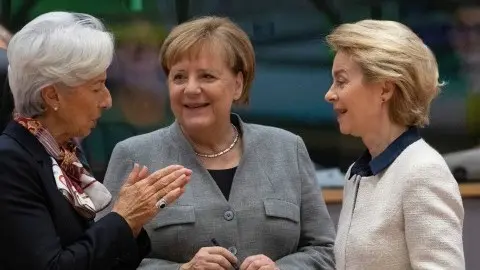The Netherlands: A milder slowdown thanks to fiscal policy
The Dutch economy is set to grow by 1.5% in 2020, something of a minor slowdown. With tax relief for households and additional spending, the government is providing a counterbalance for a reduction in investment. Environmental policies, which could have posed a downward risk, have largely been adjusted
| 1.5% |
GDP growth rate2020 forecast |
Mild slowdown as economy is supported by fiscal policy
The Dutch economy is starting to show signs of a slowdown and the outlook for investment is considerably bleaker for 2020. However, thanks to fiscal policy, no major slowdown is expected. We forecast GDP growth to decline from 1.7% in 2019 to 1.5% 2020, and 1.3% in 2021. For 2021, supply-side constraints are holding back the pace, as the labour market remains tight.
Considerable discretionary fiscal expansion

2019 in line, but investment outlook poor
2019 has developed broadly in line with our expectations. Growth in 3Q19 was quite solid, with 0.4% QoQ. Yet, investment was already posting minor falls quarter-on-quarter. Combine that with worsening business survey indicators and a still subdued global trade outlook, we suggest you shouldn't expect much from businesses as far as expenditure is concerned next year. We forecast investment growth of only 1.5% for 2020.
Boost from private investment fading

Small growth contribution from trade while external surplus remains large
Export growth is forecast again to be below historical averages, but slightly higher than in 2019. This hides a quarterly profile with a poor end to 2019 and a bad start to 2020. That's on the assumption that things get worse before they get better on the China-US trade dispute. Due to robust domestic demand growth, imports are likely to outpace exports. The current account surplus is expected to stay above 9% of GDP and, all in all, we only project a small positive net contribution of foreign trade and export growth of 2.7%.
Household consumption accelerates due to tax relief
Household consumption is forecast to accelerate to 1.7% on the back of a fiscally boosted increase in purchasing power, while ongoing real house price increases are boosting wealth. Lower employment growth and moderate confidence levels are preventing a spending spree.
Environmental policy concerns on construction and investment
Environmental legislation has been one of the significant concerns for the Dutch economy lately. Dutch policy tools for restricting nitrogen emissions did not comply with European Union standards. This became apparent in May when the Council of State published a ruling on the subject. This instantly meant a significant effect on the processing of permits for (construction) projects that involve nitrogen emissions. Construction production has slowed down as a result, but it's maintained positive growth thanks to full order books.
In November, the government announced the first mitigating measures (such as lowering the speed limit on highways) and more is promised to follow soon. This means that the delay in permit processing is reduced significantly, mitigating the effects for the construction sector and the economy as a whole.
A change in environmental approach
The second environmental issue which popped up in 2019 concerned PFAS (Polyfluoroalkyl substances which are commonly used in manufacturing but are potentially highly toxic): the government started to police very strict PFAS rules. The construction sector suffered some negative effect on production in 4Q19 since projects were either stopped immediately or delayed. Since the government significantly adjusted the rules in November, this is no longer considered a factor holding back construction on a national scale. Nevertheless, the environmental issues made us revise our construction (and accordingly investment) outlook for 2020 from 3.5% growth to only 0.5%.
Minor increase in unemployment due to extra labour supply
Unemployment is forecast to come in at 3.5% in 2020 and 2021, a little higher than in 2019. Employment growth continues, but at a much slower pace than in 2019 and below the speed of labour supply. While the Netherlands is on the eve of a decline in the working age population, labour supply continues to grow due to rising participation rates.
Consumer sentiment stabilises but business more pessimistic
Economic sentiment is close to historical averages, but underlying dynamics are different. While consumer sentiment appears to have stabilised, business sentiment seems to be on a downward trajectory. Where manufacturing was the first to lose confidence, other sectors have now also slowly started to lower their optimism. Consumers probably have lost part of their easiness due to looming cuts in pensions and increases in pension premiums. The fact that the government has recently granted a number of pension funds one-year extra time to get their coverage ratio seriously scrutinised may prevent consumer confidence from taking a nosedive in 2020. Nevertheless, it seems savings rates will be higher in 2020 than in 2019.
Lower inflation but upward pressure from wages
CPI-inflation is expected to fall from a high 2.6% year-on-year in November 2019 to 1.8% for the year in 2020, as the base effect of an increase in the reduced VAT rate and energy taxes disappears. Wage growth has been on the rise, posting 2.7% year-on-year in November for collective wage agreements, keeping the Dutch HICP inflation rate above the eurozone average for 2020.
Public finances still fully in line with EU norms
Government debt stood at 50.8% of GDP in 2Q19, safely below the European norm of 60%, and will continue to drop as a result from an increasing GDP and the sale of shares of ABN AMRO Bank. Fiscal policy is clearly expansionary, with discretionary policy adding 0.6%-points to GDP growth (according to changes in the structural budget deficit) in 2020. This is mainly the result of lower labour income tax for workers. Tax relief for business is negligible in 2020 and less than announced in the coalition agreement of 2017.
The Dutch economy in a nutshell (%YoY)

This publication has been prepared by ING solely for information purposes irrespective of a particular user's means, financial situation or investment objectives. The information does not constitute investment recommendation, and nor is it investment, legal or tax advice or an offer or solicitation to purchase or sell any financial instrument. Read more
Download
Download article
16 December 2019
ING’s Eurozone Quarterly: Is this recovery for real? This bundle contains 13 Articles